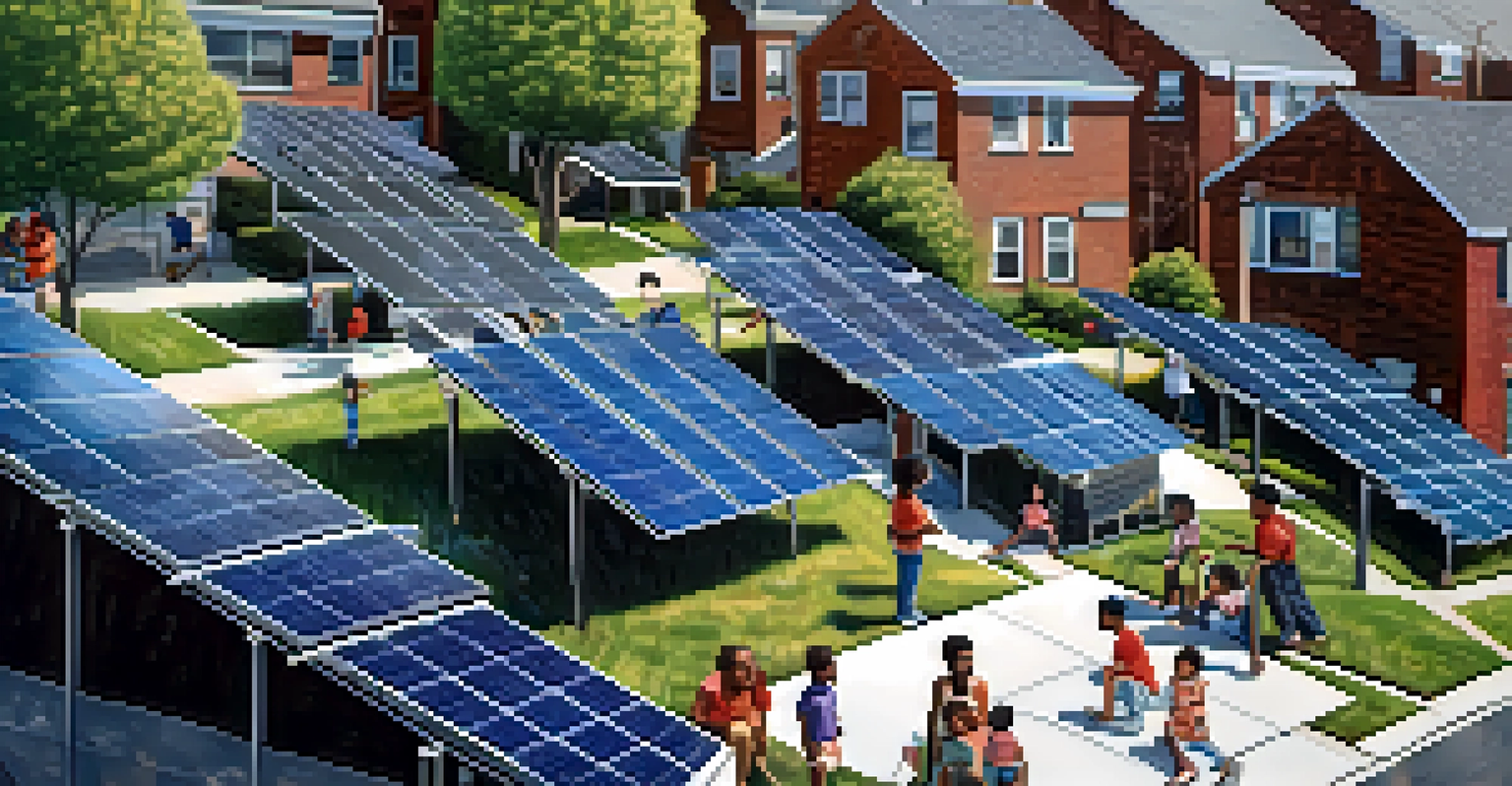Challenges Faced by NYC in Adopting Renewable Energy Solutions

High Population Density Complicates Energy Infrastructure
New York City is known for its vibrant population density, which presents unique challenges in adopting renewable energy solutions. With more than 8 million residents packed into a relatively small area, the demand for energy is incredibly high. This high demand can strain existing infrastructures, making it difficult to integrate renewable sources like solar and wind power effectively.
The greatest threat to our planet is the belief that someone else will save it.
Additionally, the city’s aged electrical grid struggles to keep up with modern energy needs, let alone the fluctuations that come with renewable energy sources. For instance, solar energy production varies with the weather, requiring a flexible grid that can accommodate these changes. Upgrading this infrastructure is not only costly but also requires time and political will, which can complicate the transition process.
In essence, the very characteristics that make New York City vibrant also present significant challenges in implementing renewable energy solutions. Balancing the needs of the population with the demands of a modernized energy grid is a complex puzzle that city planners must navigate.
Financial Constraints: Funding Renewable Projects
Implementing renewable energy projects often requires substantial upfront investment, which can be a significant hurdle for a city like NYC. While the long-term savings and environmental benefits are clear, the initial financial outlay can deter both public and private investment. This financial barrier often leads to reliance on traditional fossil fuels, which are easier to fund and implement in the short term.

Moreover, the city’s budget is already stretched thin, with competing needs in areas like housing, transportation, and public safety. Allocating funds for renewable projects can become a contentious issue among city leaders and stakeholders, who must weigh the immediate needs of their constituents against long-term sustainability goals. This often results in slow progress and missed opportunities for innovation.
Population Density Strains Energy Systems
New York City's high population density complicates the integration of renewable energy sources due to the existing infrastructure's limitations.
Ultimately, without substantial financial backing, NYC may struggle to meet its ambitious renewable energy targets. Finding the right funding mix, including federal grants, private partnerships, and public investment, is essential for overcoming this significant barrier.
Regulatory Hurdles and Policy Framework
Navigating the regulatory landscape is another challenge NYC faces in adopting renewable energy solutions. The existing policies may not be flexible enough to accommodate the rapid growth and changes associated with renewable technologies. For instance, outdated zoning laws can hinder the installation of solar panels or wind turbines in certain areas, limiting their potential impact.
We can't solve problems by using the same kind of thinking we used when we created them.
Furthermore, the process of obtaining permits for new energy projects can be lengthy and cumbersome. This bureaucratic red tape can frustrate investors and innovators who are eager to contribute to the city's renewable energy landscape. Streamlining these regulations is crucial for fostering a more conducive environment for growth and development in the renewable sector.
In short, while NYC has made strides in establishing ambitious renewable energy goals, the existing policy framework can often slow down progress. A thorough review and modernization of these regulations are essential to facilitate a smoother transition to cleaner energy.
Public Awareness and Education on Renewable Energy
Public perception plays a critical role in the adoption of renewable energy solutions. Many residents may not fully understand the benefits of renewable resources, leading to resistance against new projects. This lack of awareness can result in NIMBYism, where locals oppose the installation of renewable energy infrastructure in their neighborhoods, fearing it may affect property values or local aesthetics.
Education and outreach efforts are essential to change this narrative. By providing clear and engaging information about the advantages of renewable energy—such as lower utility bills and healthier air quality—city officials can work to foster a more supportive environment. Community workshops, school programs, and social media campaigns can all play a vital role in raising awareness and building public support.
Funding Hurdles for Renewable Projects
Substantial upfront costs and budget constraints hinder NYC's ability to invest in renewable energy initiatives despite long-term benefits.
In essence, creating a well-informed citizenry is crucial for driving the renewable energy agenda forward in NYC. When residents understand the value of clean energy, they are more likely to advocate for and embrace these projects in their communities.
Technological Challenges: Integrating Renewables
Technological challenges are significant when it comes to integrating renewable energy sources into NYC's power grid. Unlike traditional energy sources, renewables can be unpredictable; for example, solar energy is only generated when the sun is shining. This intermittency necessitates advanced technologies for energy storage and grid management to ensure a consistent power supply.
Moreover, existing energy systems may not be equipped to handle the unique demands of renewable energy. Upgrading technology, such as smart grid systems that can better manage supply and demand, is essential but can be costly and complex. This creates a barrier for cities looking to modernize their energy infrastructure while still providing reliable service to their residents.
Ultimately, overcoming these technological hurdles is crucial for NYC to achieve its renewable energy goals. Investment in research, development, and the latest technologies will be key to successfully integrating renewables into the city’s energy landscape.
Climate Resilience: Adapting to Extreme Weather
New York City is no stranger to extreme weather events, and climate resilience is a significant concern when adopting renewable energy solutions. With rising sea levels and increased frequency of storms, the city must ensure that its renewable infrastructure can withstand these challenges. This means that solar panels and wind turbines must be designed to endure harsh conditions, which can increase costs and complicate installations.
Additionally, extreme weather can disrupt energy supply and demand patterns, making it challenging to maintain a stable energy grid. For instance, heavy storms may lead to increased energy demand for heating or cooling while simultaneously damaging infrastructure. This dual challenge can strain resources and complicate the management of renewable energy sources.
Equity in Access to Renewable Energy
Ensuring equitable access to renewable energy solutions is essential for addressing environmental inequalities within New York City.
In summary, while renewable energy offers a path toward sustainability, the need for climate-resilient infrastructure cannot be overlooked. As NYC continues to face the impacts of climate change, integrating resilience into energy planning will be essential for a successful transition.
Equity and Access in Renewable Energy Initiatives
Equity is a crucial consideration in NYC's renewable energy initiatives. Low-income neighborhoods often bear the brunt of environmental issues, yet they may lack access to clean energy solutions. Without targeted efforts, the benefits of renewable energy could disproportionately favor wealthier areas, exacerbating existing inequalities within the city.
To tackle this challenge, it's vital to ensure that all communities have access to renewable energy solutions. This could include programs that subsidize solar panel installations for low-income households or community solar projects that allow multiple residents to share the benefits of a single installation. By prioritizing equity, NYC can create a more inclusive energy landscape that benefits all residents.

In conclusion, addressing equity in renewable energy initiatives is not just a matter of fairness; it's essential for achieving the city’s sustainability goals. Ensuring that all New Yorkers can participate in and benefit from the transition to renewable energy is key to building a resilient and just city.